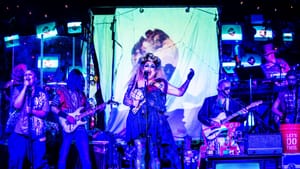Stay in the Loop
BSR publishes on a weekly schedule, with an email newsletter every Wednesday and Thursday morning. There’s no paywall, and subscribing is always free.
Mirror of ambiguity
The view from inside reTheater's 'Hedwig and the Angry Inch'

What I love most about Hedwig and the Angry Inch is its ambiguity. The show is part musical, part rock concert, and part standup-comedy/cabaret act. Its final 20 minutes have no dialogue and minimal stage direction. The title character is as ambiguous as the show’s structure.
Hedwig, born Hansel, is a self-proclaimed “slip of a girly boy” and “internationally ignored song stylist.” She undergoes an illegal (and probably back-alley) botched sex change to escape Communist Germany and quickly finds herself ditched in a trailer park, abandoned by her lover, and later ditched by another love interest who steals not only her heart but also her songs.
I won’t rehash the story — the movie is a good place to start — but the guts of what we’re talking about here is John Cameron Mitchell’s live show, which first debuted off-Broadway in 1998 and celebrates its 20th-anniversary production with reTHEATER.
Not so sweet
BSR reviewer Cara Blouin was triggered by its strong sexual nature and choreography during “Sugar Daddy,” a musical number about sex and power. This scene includes the infamous “car wash,” which is part of the scripted show.
For those not familiar with the moment, Hedwig straddles an audience member and runs the fringe of her dress over their face, exclaiming, “It’s a car wash, ladies, and gentlemen!” She then flirts and sits on audience members’ laps. It’s in good fun, and friends of cast members are usually placed in those seats. You can watch Neil Patrick Harris do this at the 2014 Tony Awards.
This moment caused an extreme reaction by Blouin, who wrote that she shut down and became extremely fearful. She later wrote that, because of her reaction, she could not review the show, and accused us of sexually assaulting audience members. It was a gross overstatement of a scripted moment in a show, with audience plants and friends of the production.
This was upsetting in several ways. Obviously, since it was a scripted moment, many in the production felt we were doing our jobs and that the good work done by the designers, actors, and musicians were not going to be reviewed because of the reviewer’s own personal baggage.
Hedwig is not some unknown entity; it has been around for 20 years. It's had off-Broadway, Broadway, and film treatments as well as four Philadelphia productions. If the nature of a 20-year-old show is too uncomfortable for a theater professional, we need to figure out how we move forward without personally attacking actors for doing their jobs. I had a long conversation with Blouin in which she apologized for her actions.

In the room where it happens
It feels healing to connect, talk, and share how two people can view one same moment so differently. I hope we all can learn from this experience. BSR's editor asked me to write about my experience in relation to the show we’re presenting.
Hedwig is a unique kind of show. Unlike most musicals, you’re actually at Hedwig's show, not watching an onstage experience at a remove. We often talked in rehearsals about how we could not do the show properly until we had that other character of the audience in the room.
Hedwig talks with the audience: she addresses them, asks them questions, and engages them directly. There is no fourth wall here. In our press release, we describe this as an immersive experience. And it is.
The nature of the show is gritty, raw, emotional, and cathartic. I feel that the Broadway production, while fun, didn’t suit the source material because it was too packaged, too clean. Hedwig is full of trauma; she’s a punk, and her world should reflect that.
As artists, it’s our job to reflect the script as authentically as possible. I feel we did that — and were then blamed for doing our jobs. Maybe we did our jobs too well.
When audiences come into a show, we want them to forget the outside. The universal rule of theater is for audiences to suspend their disbelief so they can engage in the world presented to them. However, what is not talked about as often is that the audience members must also unsuspend their disbelief when the curtain comes down.

True reflections
Hedwig is the in-between. She's oppressor and oppressed. She has taken with her all the things she claims others have taken from her. She has sex-change surgery, but is not transgender. She has neither a penis nor a vagina. Hedwig is the other both emotionally and physically; ultimately, she’s an everyman myth story, an allegorical mirror for us to confront both ends of the extremes in our own lives.
This is why we use mirrors three times in our production. Only when you see truly see yourself up close can you reflect and grow. When we do that together, in a communal theatrical experience, the power of that moment is magnified exponentially.
We’re gonna hold that mirror up to you real damn close. It might be uncomfortable, but isn’t that real? Has our “like me, follow me, tweet me” culture become terrified of facing the real?
Yes, we create a very real theatrical experience. Maybe it’s too real for some, but I think that means we are doing what is asked of us in this profession. In this moment, we are presenting a very queer punk-rock experience.
Someone quoted West Side Story in the comments of the original review, so I’ll use that metaphor here. If you think you’re going to watch Maria come out aiming a fake gun and everyone will sing “Somewhere a place for us” at the end of the show, you’ve come to see the wrong kind of theater.
But if you are willing to take a risk, if you’re willing to look in the mirror through a show that will confront your fears, sadnesses, joys and loves, come and play. We’re on a journey toward wholeness together.
reTHEATER is rethinking how we engage audiences. The company is not looking to create traditional sit-in-your-seat-and-clap-at-the-end-of-the-show theater. That is being done well by other people.
Come for an experience, and never forget that at the end it is still just theater — and Maria’s gun is not actually loaded with a bullet.
To read Mark Cofta's review, click here.
What, When, Where
Hedwig and the Angry Inch. By John Cameron Mitchell, Josh Hitchens directed. reTHEATER. Through June 30, 2018, at the Ruba Club, 416 Green Street, Philadelphia. retheater.org.
Sign up for our newsletter
All of the week's new articles, all in one place. Sign up for the free weekly BSR newsletters, and don't miss a conversation.

 Braden Chapman
Braden Chapman